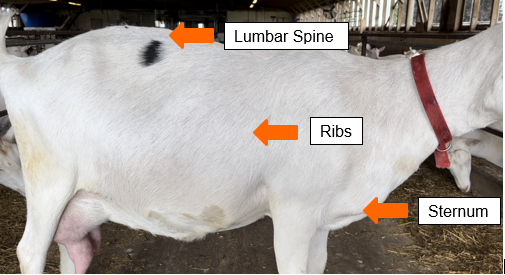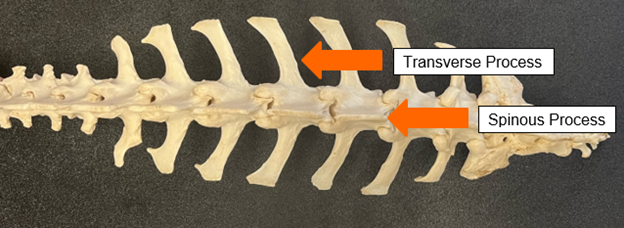Dairy goat body condition scoring
Learn about body condition scoring in dairy goats. This technical information is for dairy goat producers.
Introduction
Body condition scoring is used to assess a goat’s muscle and fat reserves through hands-on and visual assessment. It is typically used as a herd management tool and for welfare purposes. There are many benefits to body condition scoring throughout different stages of the production cycle, including: improved productivity, reproduction and health.
Body condition scoring
Body condition scoring is a management tool used to assess a goat’s fat and muscle reserves. These fat reserves are important during times such as the onset of lactation, which is when animals experience a negative energy balance. A negative energy balance occurs when the energy needed for physiological functions is greater than the nutritional intake. This occurs during the end of gestation and early lactation due to the increased energy demand due to the growing fetus(es) or the onset of lactation.
Body condition scoring should be done frequently and before management decisions are made. Some recommended times to body condition score are at the time of mating, during pregnancy and at the time of kidding. Body condition score for goats is assessed based on a scale from 1 (emaciated) to 5 (obese) and includes half scores.
Sites of assessment
Body condition scoring in goats involves both visual and physical assessment of three sites. The first site is the lumbar spine, the second is the ribs and the third is the sternum, as shown in Figure 1.

The lumbar spine is located behind the ribcage and in front of the tail. It consists of three processes (Figure 2): two short ribs that stick out on the side (transverse processes) and one that sticks out the top (the spinous process). These processes are used to assess the amount of muscle and fat in this region. The ribs are assessed by measuring the fat coverage on the ribs and the intercostal spaces. The sternum is the region between the goat’s front legs. It is assessed by using the cartilage and fat pad located in this region.

Visual assessment involves assessing the visibility of the lumbar spine and ribs:
- When visually assessing the lumbar, judge the visibility of the top of the spine and the roundness from the spinous to transverse processes.
- When assessing the ribs, note how visible the ribs are. It’s important to keep coat thickness in mind while doing your assessment as this may affect the visibility of the ribs and other areas.
Physical assessment involves the lumbar spine, ribs and sternum:
- When assessing the lumbar spine, move your fingers along the vertebrae. Assess the space between the spinous and transverse processes. Feel for the fat and muscle coverage between these processes. Try to place your fingers under the short ribs and lightly touch the top of the spine.
- When physically assessing the ribs, feel how much pressure it takes to press into the intercostal spaces.
- The sternum has cartilage and a fat pad. Assess how easily the cartilage is felt and how easily the fat pad moves, as well as its size.
Recommended body condition score targets
Body condition scores vary between lactation stages and are expected to be lowest between the time of kidding and the peak of lactation. Body condition should not drop during the dry period to accommodate for this loss. The National Code of Practice for the Care and Handling of Goats requires that a goat’s body condition score falls between a 2.0 and 4.0. Goats below BCS 2.0 or above 4.0 require immediate action to bring them back into an optimal range (Table 1).
| Body condition score | Nutritional demand | Target BCS | Acceptable range |
|---|---|---|---|
| For most stages of production | Low to moderate | 3.0 | 2.5–4.0 |
| Does at kidding, or before winter | High | 3.5 | 3.0–3.5 |
| Does at peak lactation | Very high | 2.5–3.0 | 2.0–3.5 |
| Does at breeding | High | 3.0 | 2.5–3.5 |
| Bucks at breeding | High | 3.5 | 3.0–4.0 |
Adapted from The Code of Practice for the Care and Handling of Goats.
Goat body condition score chart
Adapted from The Code of Practice for the Care and Handling of Goats.
Visual assessment
Body condition score 1
The spinous process and ribs are clearly visible.
Body condition score 2
The spinous process and some of the ribs are visible.
Body condition score 3
The spinous process is not prominent, and the ribs are difficult to see.
Body condition score 4
The spinous process and ribs are not visible. The side of the animal has a flat appearance.
Body condition score 5
The ribs are not visible, and the spinous process is buried in fat with a slight indent. The rump of the goat has an indent at the location of the spinous process.
Physical assessment
Body condition score 1
Lumbar region: the spinous process has depressions between each pair of vertebrae and can be easily pinched. The transverse process forms a continuous shelf and can be easily grasped. The transverse processes have deep depressions between each pair of vertebrae. There is little muscle felt in the space between the spinous and transverse processes.
Ribs: fingers are able to easily penetrate the intercostal spaces.
Sternum: the sternum’s fat pad can be easily moved and held between the thumb and forefinger. The cartilage is easily felt.
Body condition score 2
Lumbar region: some muscle can be felt on the spinous process. Short ribs can be grasped and form a shelf. There is a deep depression between the transverse and spinous processes.
Ribs: fingers can easily penetrate the intercostal spaces.
Sternum: the sternum’s cartilage cannot easily be felt. The fat pad can still be grasped and can move slightly.
Body condition score 3
Lumbar region: The spinous process cannot be easily grasped, and the area between each pair of vertebrae is slightly hollow. The transverse processes cannot be grasped, and the shelf is slightly noticeable. There is a smooth slope from the spinous to transverse processes.
Ribs: The intercostal spaces can be felt with pressure.
Sternum: The sternum’s cartilage can be barely felt. The fat pad barely moves and is thick and wide.
Body condition score 4
Lumbar region: The spaces between the pairs of vertebrae do not have any indents. The spinous process cannot be grasped. There is no ridge or shelf present on the transverse process. The area between the spinous and transverse processes is rounded.
Ribs: The intercostal space can be felt when strong pressure is applied.
Sternum: The sternum’s cartilage cannot be felt. The fat pad is difficult to grasp and cannot move.
Body condition score 5
Lumbar region: The individual vertebrae of the spinous and transverse processes cannot be felt. Fat bulges out in the area between the spinous and transverse processes.
Ribs: The intercostal spaces cannot be felt.
Sternum: the sternum’s cartilage cannot be felt. The fat pad cannot be grasped and cannot move.
Conclusion
There is a positive correlation between optimal body condition score and improved production, health and reproduction. Body condition scoring allows for producers to ensure that animals are within the optimal body condition score to see these benefits.
References
American Dairy Goat Association (ADGA) and University of California Davis (UC Davis). 2017. Dairy goat body condition scoring.
National Farm Animal Care Council (NFACC). 2022. Code of practice for the care and handling of goats. Retrieved from: Goats — Codes of Practice for the Care and Handling of Goats.
Ethiopia Sheep and Goat Productivity Improvement Program. 2007. Body condition scoring of sheep and goats. Retrieved from: Microsoft Word — Body condition scoring — TB No. 8.doc (langston. edu).
Susilorini, T.E., S. Maylinda, P. Surjowardojo and Suyadi. 2014. Importance of body condition score for milk production traits in Peranakan Etawah goats. Journal of Biology, Agriculture, and Healthcare. 4(3): 151–157.
Cividini, A., and M. Simčič. 2017. The effect of the body condition score at artificial insemination on prolificacy traits in Slovenian alpine goats. Agriculturae Conspectus Scientificus, 82(3): 249–253.
Jockers, E.R., V. Medina and E.S. Villagra. 2021. Influence of pre and postpartum maternal body condition score on the growth of Neuquén Crillo kids. Small Ruminant Research, 205: 106540. 10.1016/j.smallrumres.2021.106540.
Sahoo, S., C.P. Ghosh, and S. Datta. 2022. Assessment of body condition scoring (BCS) in relation to reproductive performances of Ganjam goats. The Pharma Innovation Journal. SP-11(11): 1690–1694.
Tosto, M.S.L., S.A. Santos, R.C.P. Filho, T.C.G.C. Rodrigues, I.M.C. Nicory, G.G.P. de Carvalho, R.F. Bittencourt, M.C.C. Ayres and T.C.J. Pereira. 2021. Metabolic and behavior changings during the transition period as predictors of calving proximity and welfare of dairy goats. Vet Anim Sci. 22911): 100168. Doi: 10.1016/j.vas.2021.100168.
Zobel, G., K. Leslie, D.M. Weary and M.A.G. von Keyserlink. 2015. Ketonemia in dairy goats: effect of dry period length and effect on lying behavior. J Dairy Sci. 98(9). Doi: 10.3168/jds.2014-9136.
This fact sheet was written by Marlene Paibomesai, dairy specialist, OMAFA, Kristy Blankers, dairy specialist assistant, OMAFA and Andrea Bajus, technology transfer specialist, OMAFA.